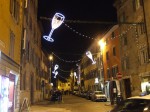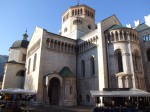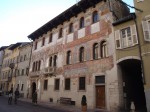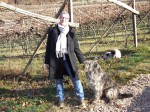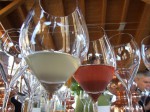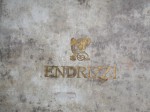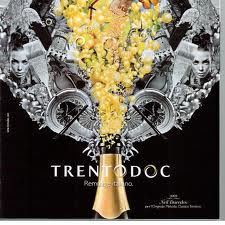
Bollicine su Trento
Italiaanse bubbels zijn er genoeg, maar welke zijn er nu precies? De bubbels uit Asti zijn bekend en Franciacorta heeft een goede naam, maar wie kent TrentoDoc? Tijd voor een nadere kennismaking.
Bubbles part 3
Bollicine su Trento
There are plenty Italian bubbles, but which ones exactly? The bubbles from Asti are well-known and Franciacorta has a good reputation, but who’s ever heard of Trentodoc? Time to get acquainted.
Trento
As the name suggests, Trentodoc are wines from Trentino, sparkling ones. Every year, in Trento, the beautiful, historical capital of this region in the North-East of Italy, the new Trentodocs are presented to press and public during Bollicine su Trento. These days everyone has a smile on it’s face, one of the enjoyable side-effects of sparkling wines.
General
Trentodoc has a certain reputation, even though there are not even 40 producers who bottle their own wine. However, there are hundreds of farmers and families that own tiny vineyards and sell their grapes to cooperatives such as Mezzacorona, Cavit en La Vis or other companies like Ferrari and the Agricultural Institute San Michele. Specific feature of TrentoDoc is the high altitude of the vineyards that provide the coolness that grapes need to develop strength and complexity. They in fact do that during a growing season that is longer than in Franciacorta’s. The average temperature in Lombardy is 13,7 °C, while aveage in Trentino-Alt Adige is 11,4. Lake Garda and the Dolomites obviously have a cooling effect. Also remarkable is, that Trentino (with Alto Adige) has an annual average of 2120 hours of sunshine, significantly more than the 1914 counted in Lombardy. The vineyards in the 58 villages within the DOC area are mostly planted with Chardonnay, complemented by smaller quantities of Pinot Noir, Pinot Blanc and Pinot Meunier. The soil varies in composition and contains, depending on the height and position in the valley, more or less limestone, shale, clay, porphyr and schistes. Some vineyards are so steep that only manual maintenance and harvesting is possible. Currently the total production is about 9 million* bottles (included are the 5 million bottles from Ferrari!), but it’s expected to grow to 11 million bottles within a few years. With these numbers TrentoDoc has a market share of around 12% of all sparkling wines in Italy. Almost 20% is exported, mainly to Germany, the Netherlands, Russia and the United States, followed by new export markets such as Brazil, India and China.
*Champagne produces about 350 million bottles, 15% of the world production of sparkling wines. Russia comes in second place, producing 300 million bottles…..
Apples and pears
Although comparison makes little sense, many look at Franciacorta and Champagne when they see, taste or buy a TrentoDoc. That’s why it’s usefull to point out the unique features. First of all, TrentoDoc is different from other sparkling wines because of it’s location. The vineyards in TrentoDoc are situated in the valley of the Adige, over 60% on hills and mountain slopes that are often steep and increasingly located higher up the hills. The latter is a response to climate change. Ferrari currently doesn’t buy any grapes from vineyards lower than 300m. Pinot Blanc and Pinot Meunier are allowed, but chardonnay is dominant in TrentoDoc, supplemented with Pinot Noir. A minimum aging on the lees of 15 moths is required for a regular TrentoDoc, 24 months for a vintage TrentoDoc and 36 months for a Riserva. It’s also required to mention the date of dégorgement on the label, very convenient when you want to buy guaranteed ‘fresh’ bottles.
The unique terroir gives TrentoDoc a lot of freshness and pure aromas. The wines are generally rich in structure and have good complexity with mineral and mediterranean aromas, hints of almonds, pepper, honey, cream and, depending on the type, fresh or dried fruit. For Riserva’s only the style Brut is allowed, but also in the regular cuvees you don’t see a lot of demi-sec or extra-dry.
Ferrari, the original
Without Giulio Ferrari (1879-1965) TrentoDoc would not be what it is today. After his studies in San Michele, Montpelier and Giesenheim, he ended up in Epernay and got aqcuainted with Champagne. He saw similarities between Trentino and Champagne and took several Chardonnay cuttings home, later known as ‘el Borgogna zalt’ or ‘yellow Burgundy’. In 1902 the first 400 bottles of sparkling wine in Trento were a fact. Ferrari has since then become the undisputed number 1 in Trento, not only in quantity, but especially in quality. Years and years of experience gives them a huge advantage over many other producers. They have developed their own, complex yeast culture, while others have to do with the standard products of San Michele, something you can really taste in many wines. When the Lunelli family took over the company in 1952, nothing of Giulio Ferrari’s philosophy was lost. In fact, under the leadership of Bruno Lunelli, and later his sons Gino, Franco and Mauro, the company grew into a national and international acknowledged value in the world of sparkling wines. Currently the company is run by the third generation of the Lunelli family having Matteo as CEO, Marcello as final-responsible winemaker, Allesandro as a member of the management Board and Camilla as head of communications and PR. Who tastes the regular cuvee from Ferrari will not be dissapointed, the quality is excellent and so is the price. However, the vintage sparklers are more interesting. Quality is clearly increasing with the extremely pleasant Perlé series, tasteful Maximum Rosé, beautiful Riserva Lunelli and the unsurpassed Cuvée Giulio Ferrari, a wine with a minimum of 10 years aging on lie and an impressive potential to age to many years. The 1991 for instance, has lost nothing from it’s freshness and is a monumental complex wine, that doesn’t make anyone desire a sparkling wine from any other country or region. And if you find wine alone not enough, their Villa Margon and their nearby and award-winning restaurant Locanda Margon are worth a visit.
The others
Besides the large cooperatives, there are currently about 30 smaller companies that have wine with their own name on the market. In close cooperation with the Consorzio they try to emphasize the unique features of TrentoDoc and sell their wines in as well as outside of Italy. That’s not very easy. A distinctive character is not always clear, prices are uncompetitive, the packaging not very attractive and the quality sometimes less inspiring. Many use the same yeasts and techniques and due to lack of experience they often look/taste similar. A considerable number of wines have little more to offer than good intentions. Some producers got inspired by Ferrari and mature their wines for a very long time (up to 10 years) on lie. When you taste these wines, you know a few years less on the lees wouldn’t hurt the wine. Nobody’s waiting for a wine with dull, tired aromas.
The region is young, has potential, but cries out for knowledge, experience and development. Compared to TrentoDoc, Franciacorta has more to offer at this moment. Fortunately there are also producers of TrentoDoc who understand what it’s all about and are already making very fine wines. During several visits, workshops and a selection tasting with Wijnand Broer and Ruud de Jong of the sparkling wine specialist Bubbles By Bruud in Rotterdam, there were, without a doubt, several wines well worth following. To name a few, I wrote down good marks for The Riserva del Fondatore Mach from the Instituto Agrario di San Michele all’ Adige (highly rated by some colleagues but to me a bit too heavy), various cuvées and vintages of Abate Nero, the Riserva 111 pas dosé from Pedrotti, the Maso Nero Riserva Brut 2006 from Zeni, the Riserva 2007 from the relatively new domain Bellaveder, the Letrari Riserva 2007, the Riserva 2006 and Riserva Extra Brut 2004 by Cesarini and the Riserva 2007 from Endrizzi. I know that some colleagues are very enthousiastic about the Graal Riserva Brut by Altemasi di Cavit, but the 2006, 2003, 2000 as well as the 1998 couldn’t get me very exited.
Methius
As far as I’m concerned the wines from Methius surpass all. Methius is the crown jewel of the Dorigati winery, owned by Charles and Henry Dorigati Paternoster. The vineyards for Methius are located in the hills from Faedo and Pressano at 350 to 500m altitude and are planted with pergola pruned Chardonay (60%) and Pinot Noir (40%). A part of the Chardonnay ferments in barriques, the rest in stainless steel. Maturation on lie lasts approximately 5 years, depending on the vintage. The production is only 15,000 bottles of their Riserva. A pity, because to me, Methius is the only wine that equals the extremely high quality of the top line from Ferrari. The Methius 2002, 2005 and 2006 are phenomenal, powerful, complex wines with an enormous potential that requires bottle aging or decanting. Unfortunately not (yet) available in Holland, but there are rumours that that’s about to change. I hope so…..
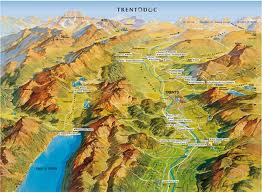 Trento
Trento
Zoals de naam reeds doet vermoeden, is een TrentoDoc een wijn uit Trentino, een mousserende. In Trento, de schitterende, historische hoofdstad van deze regio in het Noord-Oosten van Italie, worden elk jaar de nieuwe TrentoDoc’s gepresenteerd aan pers en publiek tijdens Bollicine su Trento.
Het zijn dagen waarop iederen een glimlach op het gezicht heeft, de heerlijke bijwerkingen van een glas mousserende wijn.
Algemeen
TrentoDoc heeft een zekere reputatie maar kent nog geen 40 producenten die zelf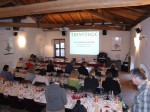 bottelen. Wel zijn er honderden wijnboeren en families met kleine wijngaardjes die hun druiven verkopen aan coöperaties als
bottelen. Wel zijn er honderden wijnboeren en families met kleine wijngaardjes die hun druiven verkopen aan coöperaties als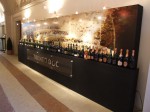 Mezzacorona, Cavit en La Vis of Ferrari en het Landbouw Instituut San Michele. Specifiek kenmerk van TrentoDoc is de hoge ligging van de wijngaarden die de koelte geeft die de druiven nodig hebben om kracht en complexiteit te ontwikkelen. dan doen ze tijdens een groeiseizoen dat, opmerkelijk genoeg, langer duurt dan in Franciacorta. De gemiddelde temperatuur in Lombardije immers bedraagt 13,7 °C, die in Trentino-Alt Adige 11,4. Het Gardameer en de Dolomieten hebben overduidelijk een verkoelende invloed. Opmerkelijk is ook dat Trentino(met Alto Adige) wel gemiddeld 2120 zonuren telt, beduidend meer dan de 1914 in Lombardije. De wijngaarden in de 58 dorpen
Mezzacorona, Cavit en La Vis of Ferrari en het Landbouw Instituut San Michele. Specifiek kenmerk van TrentoDoc is de hoge ligging van de wijngaarden die de koelte geeft die de druiven nodig hebben om kracht en complexiteit te ontwikkelen. dan doen ze tijdens een groeiseizoen dat, opmerkelijk genoeg, langer duurt dan in Franciacorta. De gemiddelde temperatuur in Lombardije immers bedraagt 13,7 °C, die in Trentino-Alt Adige 11,4. Het Gardameer en de Dolomieten hebben overduidelijk een verkoelende invloed. Opmerkelijk is ook dat Trentino(met Alto Adige) wel gemiddeld 2120 zonuren telt, beduidend meer dan de 1914 in Lombardije. De wijngaarden in de 58 dorpen 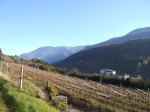 binnen de DOC zijn voornamelijk aangeplant met Chardonnay, aangevuld met kleinere hoeveelheden Pinot Noir, Pinot Blanc en Pinot Meunier. De bodem varieert van samenstelling en bevat, afhankelijk van de hoogte en positie in de vallei, meer of juist minder kalk, leisteen, klei, porfier of schiste.
binnen de DOC zijn voornamelijk aangeplant met Chardonnay, aangevuld met kleinere hoeveelheden Pinot Noir, Pinot Blanc en Pinot Meunier. De bodem varieert van samenstelling en bevat, afhankelijk van de hoogte en positie in de vallei, meer of juist minder kalk, leisteen, klei, porfier of schiste. 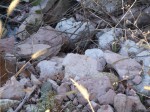 Sommige wijngaarden zijn zo steil, dat uitsluitend handmatig onderhoud en oogsten mogelijk is. Momenteel bedraagt de totale productie zo’n 9 miljoen* flessen TrentoDoc (waarvan er 5 miljoen voor rekening komen van Ferrari!), maar men verwacht binnen enkele jaren naar 11 miljoen flessen te kunnen groeien. Deze aantallen geven TrentoDoc momenteel een marktaandeel van circa 12% van alle mousserende wijnen in Italie. Bijna 20% wordt geëxporteerd, vooral naar Duitsland, Nederland, Rusland en de Verenigde Staten met in hun kielzog nieuwe exportmarkten als Brazilië, India en China.
Sommige wijngaarden zijn zo steil, dat uitsluitend handmatig onderhoud en oogsten mogelijk is. Momenteel bedraagt de totale productie zo’n 9 miljoen* flessen TrentoDoc (waarvan er 5 miljoen voor rekening komen van Ferrari!), maar men verwacht binnen enkele jaren naar 11 miljoen flessen te kunnen groeien. Deze aantallen geven TrentoDoc momenteel een marktaandeel van circa 12% van alle mousserende wijnen in Italie. Bijna 20% wordt geëxporteerd, vooral naar Duitsland, Nederland, Rusland en de Verenigde Staten met in hun kielzog nieuwe exportmarkten als Brazilië, India en China.
* Champagne produceert jaarlijks ongeveer 350 miljoen flessen, 15% van de wereldproductie aan mousserende wijnen. Rusland komt op de tweede plaats met circa 300 miljoen flessen…..
Appels en peren
Hoewel vergelijken weinig zinvol is, kijken velen met een schuin oog naar Franciacorta en Champagne als ze een TrentoDoc zien, proeven of kopen. Het is daarom handig de unieke eigenschappen nog even aan te halen. TrentoDoc verschilt van de eerder genoemde wijnen vooral door haar ligging. De wijngaarden 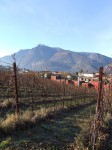 in de TrentoDoc liggen in de vallei van de Adige met ruim 60% op heuvels en berghellingen die vaak steil zijn en steeds hoger liggen. Dit laatste is een reactie op de klimaatsveranderingen. Ferrari koopt momenteel zelfs geen druiven meer van wijngaarden die niet hoger dan 300 meter liggen. Pinot Blanc en Pinot Meunier zijn toegestaan, maar men werkt voornamelijk met Chardonnay, aangevuld met Pinot Noir. Qua lagering geldt een minimale rijping op de lie na de botteling (en niet voor 1 januari na de oogst) van 15 maanden voor een reguliere TrentoDoc, 24 maanden voor een TrentoDoc met jaargang en 36 maanden voor een Riserva. Voorgeschreven is dat de datum van het dégorgement op het etiket moet worden vermeld, erg handig als je gegarandeerd ’verse’ flessen wil kopen. De unieke terroir geeft TrentoDoc veel fraîcheur en pure aroma’s van het begin tot het einde. De wijnen hebben over het algemeen een rijke structuur en goede complexiteit met minerale en Mediterrane aroma’s, accenten van amandelen, peper, honing, crème en, afhankelijk van het type, vers of juist gedroogd fruit. Voor Riserva’s is alleen de stijl Brut toegestaan, maar ook van de reguliere cuvees zie je weinig demi-sec of extra-dry.
in de TrentoDoc liggen in de vallei van de Adige met ruim 60% op heuvels en berghellingen die vaak steil zijn en steeds hoger liggen. Dit laatste is een reactie op de klimaatsveranderingen. Ferrari koopt momenteel zelfs geen druiven meer van wijngaarden die niet hoger dan 300 meter liggen. Pinot Blanc en Pinot Meunier zijn toegestaan, maar men werkt voornamelijk met Chardonnay, aangevuld met Pinot Noir. Qua lagering geldt een minimale rijping op de lie na de botteling (en niet voor 1 januari na de oogst) van 15 maanden voor een reguliere TrentoDoc, 24 maanden voor een TrentoDoc met jaargang en 36 maanden voor een Riserva. Voorgeschreven is dat de datum van het dégorgement op het etiket moet worden vermeld, erg handig als je gegarandeerd ’verse’ flessen wil kopen. De unieke terroir geeft TrentoDoc veel fraîcheur en pure aroma’s van het begin tot het einde. De wijnen hebben over het algemeen een rijke structuur en goede complexiteit met minerale en Mediterrane aroma’s, accenten van amandelen, peper, honing, crème en, afhankelijk van het type, vers of juist gedroogd fruit. Voor Riserva’s is alleen de stijl Brut toegestaan, maar ook van de reguliere cuvees zie je weinig demi-sec of extra-dry.
Ferrari, het origineel
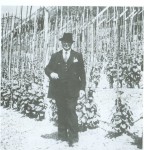 Zonder Giulio Ferrari (1879-1965) zou TrentoDoc niet zijn wat het vandaag de dag is. Hij was het namelijk, die na zijn studies in San Michele, Montpellier en Geisenheim in Epernay terecht kwam en Champagne leerde kennen. Hij zag zekere overeenkomsten tussen Trentino en Champagne en nam enkele Chardonnay-stekken mee die daarna bekend als ‘el Borgogna zalt’ oftewel ‘gele Bourgogne’. In 1902 waren de eerste 400 flessen mousserende wijn in Trento een feit. Ferrari heeft zich sinds die tijd ontwikkeld tot de absolute nummer 1 in Trento, niet alleen in kwantiteit, maar vooral in kwaliteit. De jarenlange ervaring geeft ze een enorme voorsprong op veel andere producenten. Zo hebben ze een eigen, zeer complexe gistcultuur kunnen ontwikkelen, terwijl anderen het moeten doen met standaard producten van San Michele, wat niet zelden te proeven is. Met de overname van het bedrijf door de familie Lunelli in 1952 is niets verloren gegaan van de filosofie van Giulio Ferrari.
Zonder Giulio Ferrari (1879-1965) zou TrentoDoc niet zijn wat het vandaag de dag is. Hij was het namelijk, die na zijn studies in San Michele, Montpellier en Geisenheim in Epernay terecht kwam en Champagne leerde kennen. Hij zag zekere overeenkomsten tussen Trentino en Champagne en nam enkele Chardonnay-stekken mee die daarna bekend als ‘el Borgogna zalt’ oftewel ‘gele Bourgogne’. In 1902 waren de eerste 400 flessen mousserende wijn in Trento een feit. Ferrari heeft zich sinds die tijd ontwikkeld tot de absolute nummer 1 in Trento, niet alleen in kwantiteit, maar vooral in kwaliteit. De jarenlange ervaring geeft ze een enorme voorsprong op veel andere producenten. Zo hebben ze een eigen, zeer complexe gistcultuur kunnen ontwikkelen, terwijl anderen het moeten doen met standaard producten van San Michele, wat niet zelden te proeven is. Met de overname van het bedrijf door de familie Lunelli in 1952 is niets verloren gegaan van de filosofie van Giulio Ferrari. 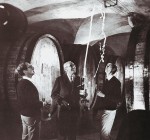 Sterker nog, onder leiding van Bruno Lunelli en later zijn zoons Gino, Franco en Mauro, groeide de onderneming uit tot een nationaal en internationaal begrip op het gebied van mousserende wijnen. Op dit moment wordt het bedrijf geleid door de derde generatie van de Lunelli familie met Mattteo als CEO, Marcello als eindverantwoordelijk wijnmaker, Alessandro als lid van de
Sterker nog, onder leiding van Bruno Lunelli en later zijn zoons Gino, Franco en Mauro, groeide de onderneming uit tot een nationaal en internationaal begrip op het gebied van mousserende wijnen. Op dit moment wordt het bedrijf geleid door de derde generatie van de Lunelli familie met Mattteo als CEO, Marcello als eindverantwoordelijk wijnmaker, Alessandro als lid van de 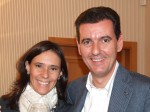 directie en Camilla als hoofd communicatie en PR.
directie en Camilla als hoofd communicatie en PR.
Wie de reguliere cuvee van Ferrari proeft wordt niet teleurgesteld, de kwaliteit is prima en de prijs ook. Interessanter wordt het echter bij de jaargangwijnen. De kwaliteit neemt hier duidelijk toe met een uiterst aangename Perlé-serie, smaakvolle Maximum Rosé, schitterende Riserva Lunelli en de onovertroffen Cuvée Giulio Ferrari, een wijn met minimaal 10 jaar rijping op lie en een indrukweekend bewaarpotentieel. Ongekend mooi zijn ze, met een 1991 die nog niets aan frisheid heeft ingeboet; een monumentale, complexe wijn die naar geen enkele andere mousserende wijnen uit welk land of welke streek dan ook doet verlangen.
een wijn met minimaal 10 jaar rijping op lie en een indrukweekend bewaarpotentieel. Ongekend mooi zijn ze, met een 1991 die nog niets aan frisheid heeft ingeboet; een monumentale, complexe wijn die naar geen enkele andere mousserende wijnen uit welk land of welke streek dan ook doet verlangen.
En mocht voor bezoekers aan Trentino of Ferrari wijn alleen niet genoeg zijn, een bezoek aan de Villa Margon en hun nabijgelegen en bekroonde restaurant Locanda Margon is meer dan de moeite waard…
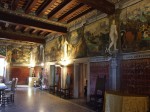
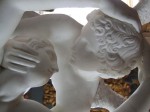
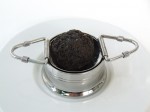
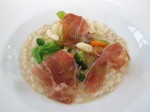
De anderen
Naast de grote coöperaties, zijn er momenteel circa 30 kleinere bedrijven die de wijn onder hun eigen naam op de markt brengen. In nauwe samenwerking met het consorzio proberen ze de unieke eigenschappen van TrentoDoc te benadrukken en ook hun wijnen in en buiten Italie te verkopen. Heel gemakkelijk is dat niet. Het onderscheidende vermogen is niet altijd duidelijk, de prijzen zijn weinig concurrerend, de uitmonstering niet altijd even aantrekkelijk en de kwaliteit vaak minder inspirerend. Door het gebruik van veel dezelfde gisten, technieken en gebrek aan ervaring, lijken ze vaak op elkaar en blijven de nodige wijnen steken in goede bedoelingen.
Enkele producenten hebben zich door Ferrari laten inspireren en rijpen hun wijnen zeer lang (tot wel 10 jaar) op lie. Wie ze echter proeft, wenst dat ze die rijping iets korter hadden gemaakt. Op wijnen met vermoeide aroma’s zit immers niemand te wachten. De 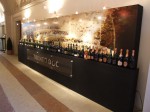 streek is jong, heeft potentieel, maar schreeuwt om verdere ontwikkeling. Wat dat betreft is Franciacorta veel verder. Gelukkig zijn er ook TrentoDoc-producenten die ‘het’ snappen en al erg fraaie wijnen maken. Tijdens diverse bezoeken, workshops en een selectieproeverij met Wijnand Broer en Ruud de Jong van mousserend wijnspecialist Bubbels by Bruud, bleken er verschillende die zonder twijfel de moeite van het volgen waard zijn.
streek is jong, heeft potentieel, maar schreeuwt om verdere ontwikkeling. Wat dat betreft is Franciacorta veel verder. Gelukkig zijn er ook TrentoDoc-producenten die ‘het’ snappen en al erg fraaie wijnen maken. Tijdens diverse bezoeken, workshops en een selectieproeverij met Wijnand Broer en Ruud de Jong van mousserend wijnspecialist Bubbels by Bruud, bleken er verschillende die zonder twijfel de moeite van het volgen waard zijn. 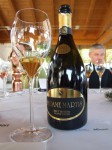 Goed scoorden o.a. de Riserva del Fondatore Mach van het Istituto Agrario di San Michele all’Adige (hoewel voor mij wat aan de zware tot zelfs logge kant), diverse cuvées en jaargangen van Abate Nero, de Riserva 111 pas dosé van Pedrotti, de Maso Nero Riserva Brut 2006 van Zeni, de Riserva 2007 van het relatief nieuwe domein Bellaveder, de Letrari Riserva 2007, de Riserva 2006 en Riserva Extra Brut 2004 van Cesarini en de Riserva 2007 van Endrizzi. Ik weet dat sommige collega’s ook erg enthousiast zijn over de Graal Riserva Brut van Altemasi di Cavit, maar zowel de 2006, 2003, 2000 als 1998 konden me niet echt bekoren. Er zijn volgens mij duidelijk betere wijnen.
Goed scoorden o.a. de Riserva del Fondatore Mach van het Istituto Agrario di San Michele all’Adige (hoewel voor mij wat aan de zware tot zelfs logge kant), diverse cuvées en jaargangen van Abate Nero, de Riserva 111 pas dosé van Pedrotti, de Maso Nero Riserva Brut 2006 van Zeni, de Riserva 2007 van het relatief nieuwe domein Bellaveder, de Letrari Riserva 2007, de Riserva 2006 en Riserva Extra Brut 2004 van Cesarini en de Riserva 2007 van Endrizzi. Ik weet dat sommige collega’s ook erg enthousiast zijn over de Graal Riserva Brut van Altemasi di Cavit, maar zowel de 2006, 2003, 2000 als 1998 konden me niet echt bekoren. Er zijn volgens mij duidelijk betere wijnen.
Methius
Wat mij betreft overtreffen de wijnen van Methius allen. Methius is het kroonjuweel van het wijnhuis Dorigati, eigendom van Charles en Henry Dorigati Paternoster. De wijngaarden voor de Methius liggen in heuvels van Faedo en Pressano op 350 tot 500 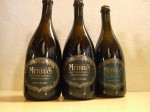 meter hoogte en zijn aangeplant met pergola gesnoeide Chardonnay (60%) en Pinot Noir (40%). Een deel van de Chardonnay vergist in barriques, de rest in RVS. Rijping op lie duurt gemiddeld 5 jaar. Van hun Riserva worden jaarlijks slechts 15.000 flessen gemaakt. Jammer, want Methius is in mijn ogen de enige wijn die het extreem hoge kwaliteitsniveau van de toplijn van Ferrari evenaart. De Methius 2002, 2005 en 2006 zijn fenomenaal; krachtige, complexe wijnen met een enorm potentieel dat om lange flesrijping of decanteren vraagt. Helaas (nog) niet in Nederland verkrijgbaar, maar daar komt wellicht binnenkort verandering in. Tenminste dat hoop ik…….
meter hoogte en zijn aangeplant met pergola gesnoeide Chardonnay (60%) en Pinot Noir (40%). Een deel van de Chardonnay vergist in barriques, de rest in RVS. Rijping op lie duurt gemiddeld 5 jaar. Van hun Riserva worden jaarlijks slechts 15.000 flessen gemaakt. Jammer, want Methius is in mijn ogen de enige wijn die het extreem hoge kwaliteitsniveau van de toplijn van Ferrari evenaart. De Methius 2002, 2005 en 2006 zijn fenomenaal; krachtige, complexe wijnen met een enorm potentieel dat om lange flesrijping of decanteren vraagt. Helaas (nog) niet in Nederland verkrijgbaar, maar daar komt wellicht binnenkort verandering in. Tenminste dat hoop ik…….
